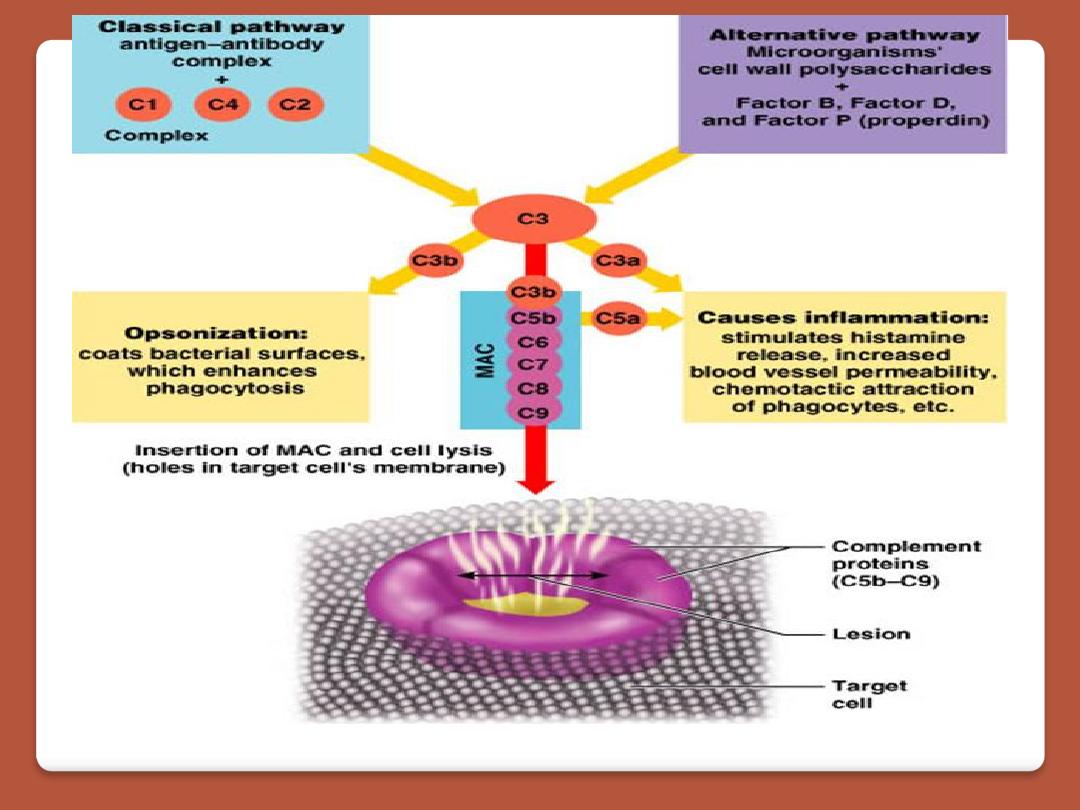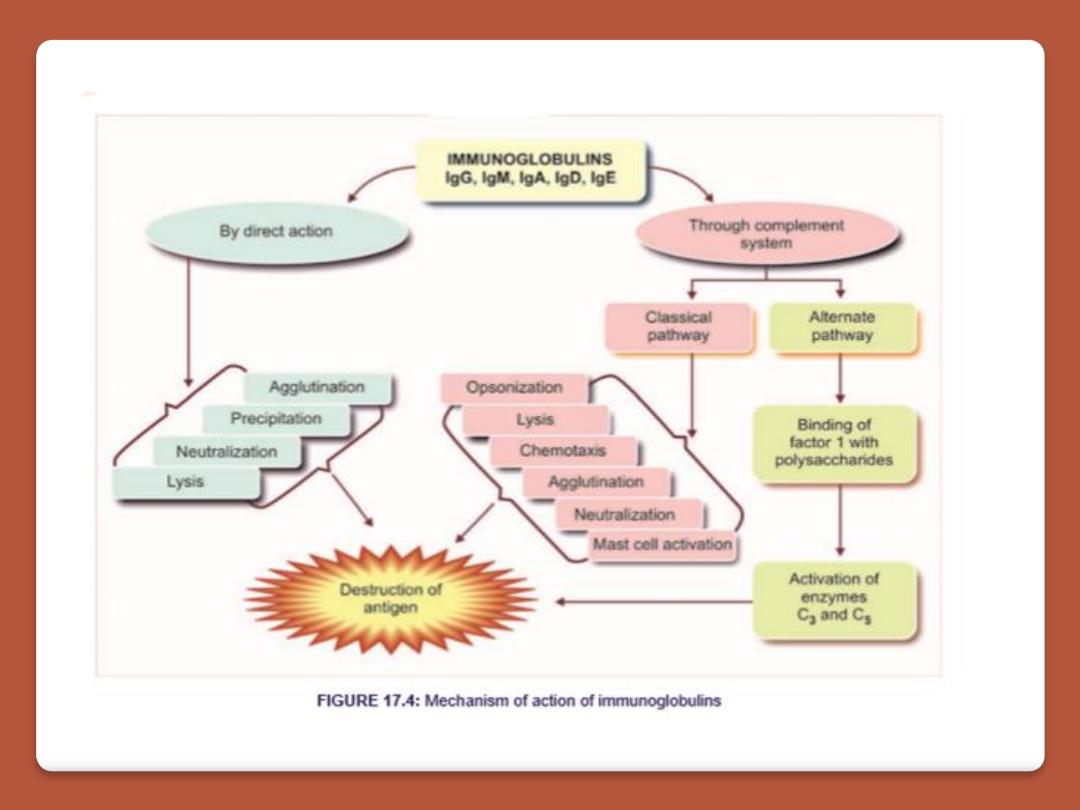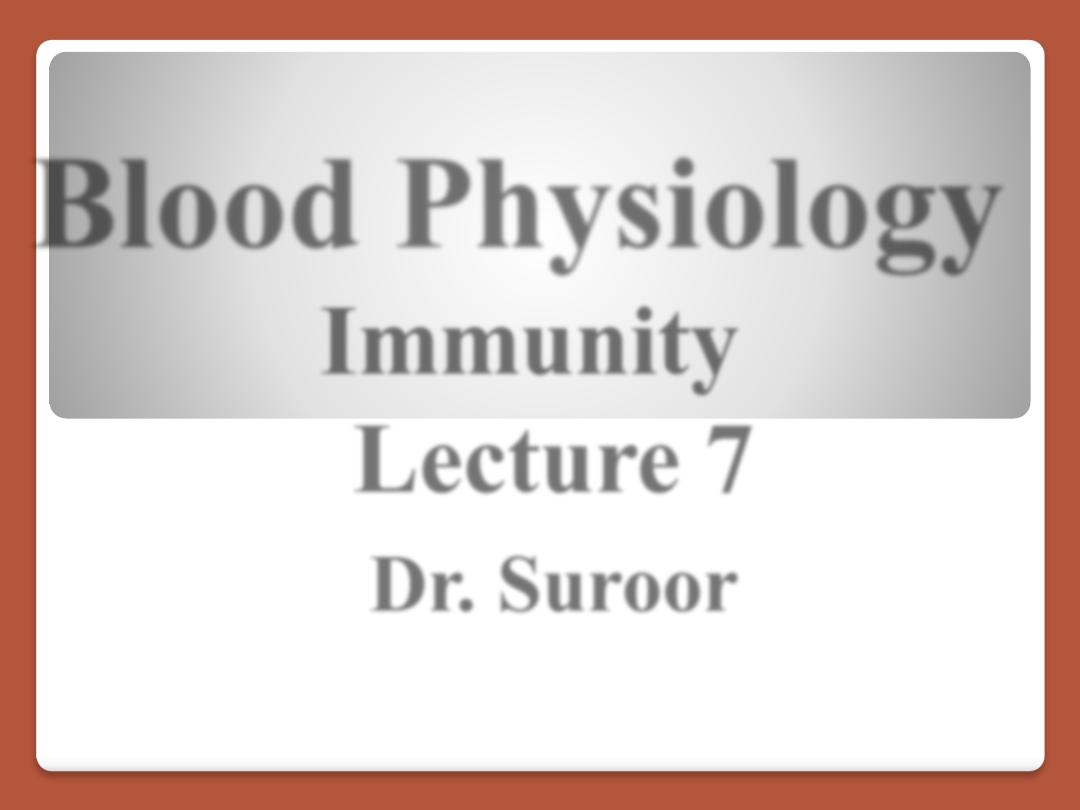
Blood Physiology
Immunity
Lecture 7
Dr. Suroor
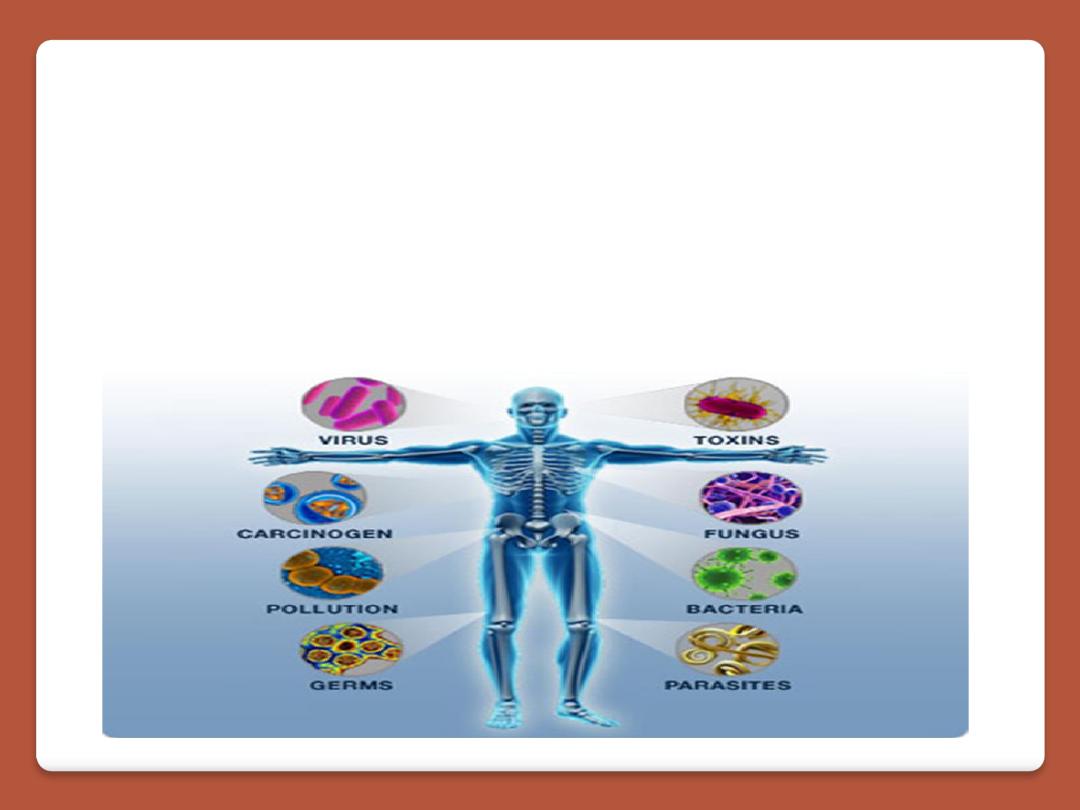
Immunity
is body's ability to resist or eliminate
potentially harmful foreign materials or abnormal
cells like bacteria, virus, toxic substances.
Immunity is of two types:
I. Innate immunity.
II. Acquired immunity.

Consists of following activities:
Defense against invading pathogens (viruses & bacteria)
Removal of 'worn-out' cells (e.g., old RBCs) & tissue debris (e.g.,
from injury or disease)
Identification & destruction of abnormal or mutant cells (primary
defense against cancer)
Rejection of 'foreign' cells (e.g., organ transplant)
Inappropriate responses:
Allergies - response to normally harmless substances
Autoimmune diseases
The immunity of 2 main types : Innate (natural)& Acquired
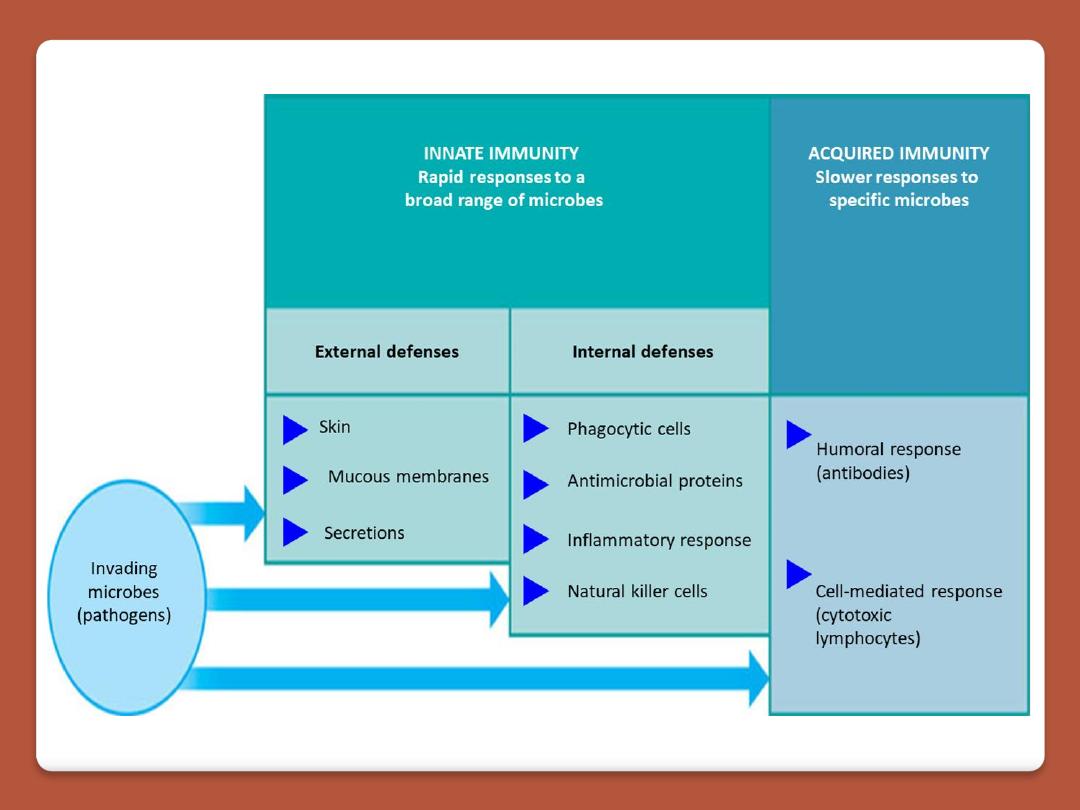

Innate immunity is the inborn capacity of the body to resist
pathogens. if the organisms enter the body, innate immunity
eliminates them before the development of any disease.
It is called the natural or non-specific immunity, represents the
first line of defense against any type of pathogens
Innate or natural immunity involving:
1. Phagocytosis of bacteria and other invaders by white blood cells
and cells of the tissue macrophage system
2. Destruction of swallowed organisms by the acid secretions of the
stomach and the digestive enzymes.
3. Resistance of the skin to invasion by organisms.
4. Presence in the blood of certain chemicals and cells that attach to
foreign organisms or toxins and destroy them.
Innate immunity
relies on mechanisms already existing before microbe infects host
is the first line of defense
has no memory for subsequent exposure
relies on non specific mechanisms

The cells that mediate innate immunity include neutrophils,
macrophages, and natural killer (NK) cells, large lymphocytes
cytotoxic one . All these cells respond to lipid and carbohydrate
sequences unique to bacterial cell walls and to other substances
characteristic of tumor and transplant cells.

„
ACQUIRED IMMUNITY OR SPECIFIC IMMUNITY
Acquired immunity is the resistance developed in the body
against any specific foreign body like bacteria, viruses, toxins,
vaccines or transplanted tissues , known as specific
immunity.
It is the most powerful immune mechanism that protects the
body from the invading organisms or toxic substances.
Lymphocytes
are responsible for acquired immunity
Two types of acquired immunity develop in the body:
1. Cellular immunity
2. Humoral immunity
Adaptive immunity
develops following entry of microbe into the host
comes into action after innate immunity fails to get rid of
microbe
has memory to deal with subsequent exposure
happens through specific cells
T cells (cell mediated)
B cells (antibody mediated

Humoral immunity
is mediated by circulating immunoglobulin
antibodies in the γ-globulin fraction of the plasma proteins. Humoral
immunity is a major defense against bacterial infections.
Immunoglobulins
are produced by B lymphocytes, and they activate the
complement system and attack and neutralize antigens.
Cellular immunity
is mediated by T lymphocytes. It is responsible for
delayed allergic reactions and rejection of transplants of foreign tissue.
Cytotoxic T cells attack and destroy cells that have the antigen which
activated them. Cellular immunity constitutes a major defense against
infections due to viruses, fungi, and a few bacteria such as the tubercle
bacillus. It also helps defend against tumors.

Development of the Immune System
During fetal development, lymphocyte precursors
come from the bone marrow. Those that populate
the
thymus
become transformed by the environment in
this organ into the lymphocytes responsible for cellular
immunity
(T lymphocytes).
humoral immunity
(B lymphocytes
the transformation
to B lymphocytes occurs in
bursal equivalents
, ie, the
fetal liver and, after birth, the
bone
marrow. After
residence in the thymus or liver, many of the T and B
lymphocytes migrate to the lymph nodes and bone
marrow. Most of the processing occurs during fetal and
neonatal life. However, there is also a slow, continuous
production of new lymphocytes from stem cells in
adults.


B cells
differentiate
into plasma cells and memory B cells.
Memory B cells “remember” specific antigens and can launch fast
immune response if antigen is encountered again.
three major types
of T cells
:
cytotoxic T cells, helper T cells, and
memory T cells.
There are two subtypes of
helper T cells
:
T helper 1 (TH1) cells secrete IL-2 and γ-interferon and are concerned
primarily with cellular immunity;
T helper 2 (TH2) cells secrete IL-4 and IL-5 and interact primarily with
B cells in relation to humoral immunity.
Cytotoxic T cells
destroy transplanted and other foreign cells, with their
development aided and directed by helper T cells.

Markers on the surface of lymphocytes are assigned CD (clusters of
differentiation) numbers on the basis of their reactions to a panel of
monoclonal antibodies. Most
cytotoxic T
cells display the glycoprotein
CD8,
CD8+ T cells destroy infected cells containing microbes or microbial proteins
and
helper T
cells display the glycoprotein
CD4.
CD4+ T cells activate
phagocytes to kill microbes
These proteins are closely associated with the T cell receptors and may
function as coreceptors.
Natural killer cells
are also cytotoxic lymphocytes, though they are not T cells.
limits the spread of tumors and microbial infections by inducing apoptosis in
cells, limiting tissue damage
Memory B Cells & T Cells
After exposure to a given antigen, a small number of activated B and
T cells persist as memory B and T cells. These cells are readily
converted to effector cells by a later encounter with the same
antigen. This ability to produce an accelerated response to a second
exposure to an antigen is a key characteristic of acquired immunity.
The ability persists for long periods of time, and in some instances
(eg, immunity to measles) it can be lifelong.
It had been argued that the long life of memory cells involves their
repeated exposure to small amounts of antigen.

Role of the T Cells in Activation of the B Lymphocytes.
Most antigens activate both T lymphocytes and B lymphocytes at the
same
time
, some of the
T-cells that
are formed, called T-helper cells, secrete
specific substances (collectively called lymphokines) that activate the specific
B lymphocytes
. Indeed, without the aid of these T-helper cells, the quantity of
antibodies formed by the B lymphocytes is usually slight.
Formation of Antibodies by Plasma Cells
.
Before exposure to a specific antigen, the clones of B lymphocytes remain
dormant in the lymphoid tissue. Upon entry of a foreign antigen, macrophages in
lymphoid tissue phagocytize the antigen and then present it to adjacent B
lymphocytes.
the antigen is presented to T cells at the same time, and activated T-helper
cells are formed. These helper cells also contribute to extreme activation of the B
lymphocytes. The B lymphocytes specific for the antigen immediately enlarge
and take on the appearance of lymphoblasts
The mature plasma cell then produces gamma globulin antibodies at an
extremely rapid rate—about 2000 molecules per second for each plasma cell.
the antibodies are secreted into the lymph and carried to the circulating blood.
This process continues for several days or weeks until finally exhaustion and
death of the plasma cells occur.
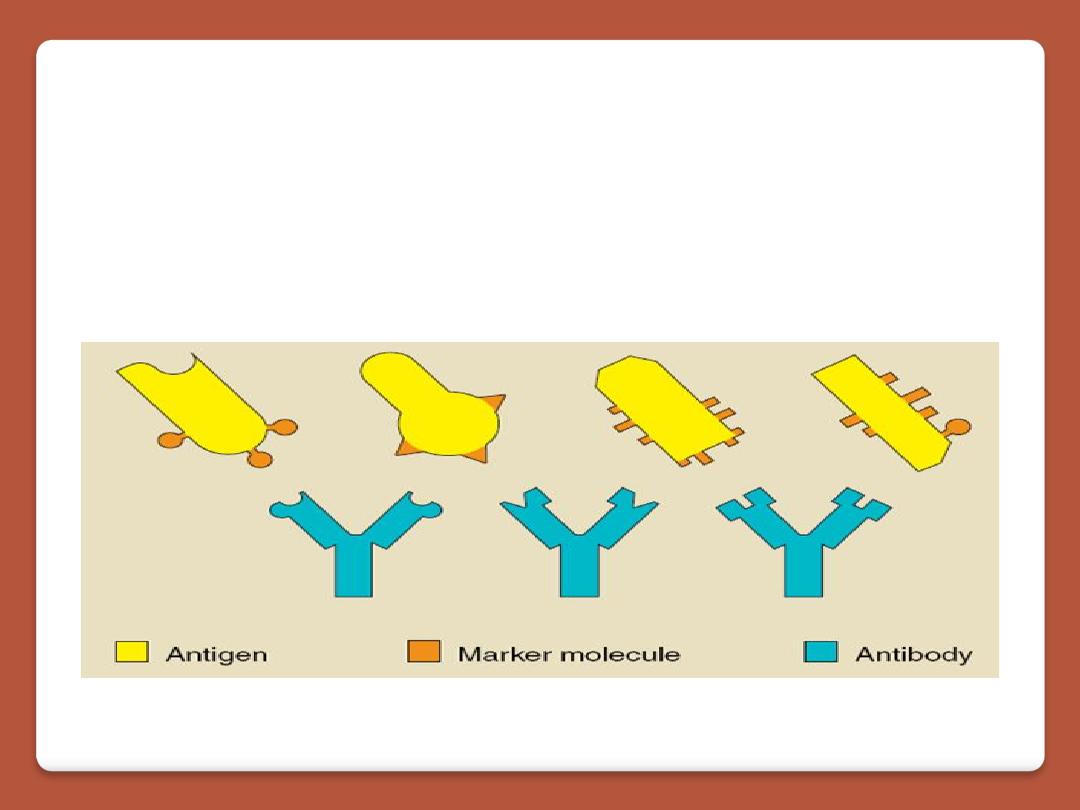
Antigen (Ag):
are the substances which induce
specific immune
reactions
in the body.
▪ It is foreign substance (
organism, toxin, vaccine, or any substance
) that is recognized
by one or more of its chemical compound mainly surface protein or polysaccharides.
Each Ag has multiple Ag determinants (
epitopes
) which are
the part of an antigen that
is actually bound by an Ab or lymphocyte Ag receptor.

Antibodies
are gamma globulins called immunoglobulins (Ig) that
have molecular weights between 160,000 and 970,000 and constitute
about 20 percent of all the plasma proteins.
All the immunoglobulins are composed of combinations of
light and
heavy polypeptide chains
. Most are a combination of two light and
two heavy chains, some of the immunoglobulins have combinations of
as many as 10 heavy and 10 light chains, which give rise to high-
molecular-weight immunoglobulins. in all immunoglobulins, each heavy
chain is paralleled by a light chain at one of its ends, thus forming a
heavy-light pair, and there are always at least 2 and as many as 10
such pairs in each immunoglobulin molecule
.
Ig as designated end of each light and heavy chain, called the
variable portion; the remainder of each chain is called the constant
portion. T
he variable portion
is different for each specific antibody, and
it is this portion that attaches specifically to a particular type of antigen.
The constant portion
of the antibody determines other properties of the
antibody. A combination of noncovalent and covalent bonds (disulfide)
holds the light and heavy chains together.
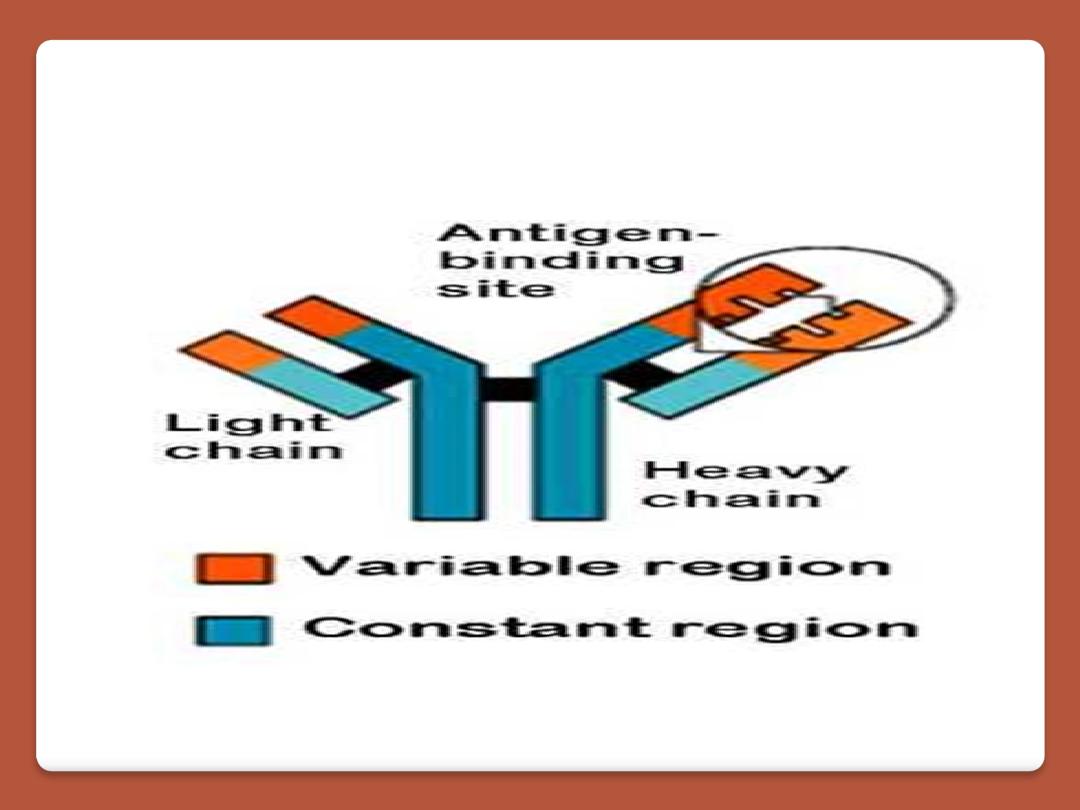
Belong to the gamma-globulin fraction of serum proteins :
Y-shaped 2 identical heavy chains 2 identical light chains
All immunoglobulins are not antibodies

Five kinds of antibodies
IgG, IgM, IgA, IgD, IgE
these classes of antibodies are from B- cells :-
1. IgG :- it has high Ag affinity and can
cross the placenta
barrier and
protect the new born for a several months .
2. IgM :- its responsible
the primary immune
response and this type can not
cross the placenta barrier .
3. IgA :- this type are present in equal a mounts in
secretion such as saliva
,
gastric juice , pancreatic and intestinal juice . it protect mucosal surface in
the guts respiratory and urinary tracts .
4. IgE :- it mainly bound to
basophiles and mast cells
and involved in the
pathogenesis of
allergic
disease .
5.IgD:- act as receptor for B lymphocyte and participate in their activation
IgG
which is a bivalent antibody and constitutes about
75
percent of the antibodies
of the normal person, provides
natural passive immunity
to the developing fetus by crossing the
placenta from mother to baby
.
IgE,
which constitutes only a small percentage of the antibodies but is especially
involved in allergy. The
IgM
class is a large share of the antibodies formed
during the primary response are of this type. These antibodies have 10 binding
sites that make them exceedingly effective in protecting the body against invaders,
even though there are not many IgM antibodies

Mechanisms of Action of Antibodies
Antibodies act mainly in two ways to protect the body against
invading agents: (1) by direct attack on the invader and (2) by
activation of the “complement system” that then has multiple
means of its own for destroying the invader.
Because of the bivalent nature of the antibodies and the
multiple antigen sites on most invading agents, the antibodies
can inactivate the invading agent in one of several ways, as
follows:
1. Agglutination, in which multiple large particles with
antigens on their surfaces, such as bacteria or red cells, are
bound together into a clump
2. . Precipitation, in which the molecular complex of soluble
antigen (such as tetanus toxin) and antibody becomes so
large that it is rendered insoluble and precipitates
3. Neutralization, in which the antibodies cover the toxic sites
of the antigenic agent
4. Lysis, in which some potent antibodies are occasionally
capable of directly attacking membranes of cellular agents and
thereby cause rupture of the agent
.

The Complement System for Antibody Action
"Complement" is a collective term to describe a system of about 20 different proteins, many of
which are
enzyme precursors.
The principal actors in this system are 11 proteins designated
C1 through C9, B, and D.
All these are present normally among the plasma proteins and also
among the plasma proteins that leak out of the capillaries into the tissue spaces. The enzyme
precursors are normally
inactive
, but Complement can be activated by two pathways:
classical and alternative
1- The Classical Pathway
Classical pathway is linked to the immune system , depends on the binding of antibodies
to invading organisms , Subsequent binding of C1 to the antigen-antibody complexes
(complement fixation)
The classical pathway is activated by an antigen-antibody reaction. ,
when an antibody binds with an antigen, a specific reactive site on the "constant" portion of
the antibody becomes uncovered, or
activated,
and this in turn binds directly with the C1
molecule of the complement system, setting into motion a "
cascade
" of sequential reactions.
2- The Alternate Pathway
Alternative pathway is triggered by interaction among factors B, D, and P, and
polysaccharide molecules present on microorganisms ,
complement system sometimes is
activated without the intermediation of an antigen-antibody reaction. This occurs especially
in response to large polysaccharide molecules in the cell membranes of some invading
microorganisms
C3a , C4a & C5a
release histamine from these cells to help in immobilization of Ag from
site of invasion & stimulate allergy & local inflammation.
Chemotaxis: C5a
is chemotactic substance to neutrophils & monocytes
.
